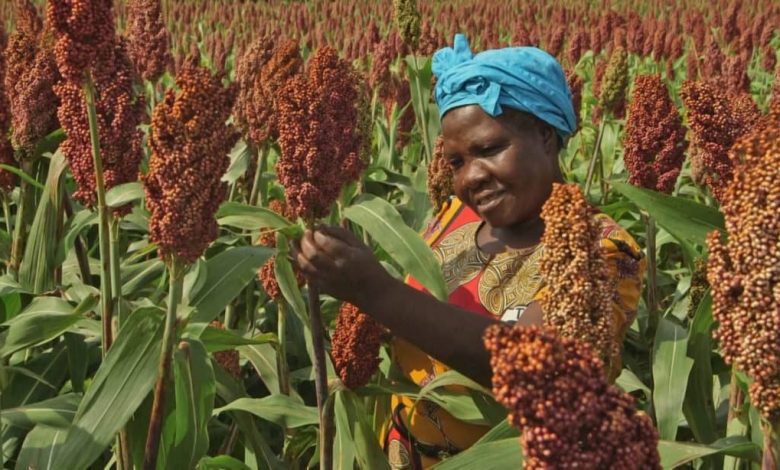The many things sorghum and finger millet can give you

Did you know that you can make wine and juice from sorghum stalks or cakes from finger millet flour?
And as dry spells become more common, why not grow the two crops that are drought-resistant and make nutritious silage from them if you are a livestock farmer to avoid reliance on maize?
The products are some of the items that were on display during a recent exhibition by the International Crops Research Institute for the Semi-Arid Tropics (ICRISAT) in Nairobi on the usage of the two dryland crops.
Sorghum mainly thrives in dry areas, where it grows with little rains. After harvesting the grains, most farmers feed the stalks to their animals or leave them to dry on the farm, regarding them as waste.
However, according to Winnie Nyonje, a food science and nutrition researcher from the Jomo Kenyatta University of Agriculture and Technology (JKUAT), farmers can turn the stalks into wine or juice.
“Sorghum is referred to as desert sugarcane because of its adaptability in dryer and warmer climates. Sweet sorghum is a variety that accumulates high levels of sugars in the juicy stems and produces high biomass,” says Nyonje.
To make the wine, harvest the stalks as soon as the grains have been removed. The heads should be cut off when the grains are mature enough, past the milk stage. “The stalks should be cut while still green and grains are mature,” she adds.
At this stage, the stalk has a high amount of juice. All the leaves are removed, stalks washed and the juice is extracted using a roller cane extractor or stalk crusher.
“The amount of juice depends on the stage of harvest as well as the agronomic yield of the plants. The juice is then fermented into sorghum wine. The sweet sorghum juice is rich in natural sugar and has high content of nitrogenous matter, which promote growth of yeast and hence fermentation,” she explains.
The wine can be blended with watermelon, pineapple and grapes, and has an alcohol content of 12 percent.
Acid content can be achieved after 21 days of fermentation, which keeps it stable and safe for prolonged storage.
For ready-to-drink juices, they are either singly or blended with others such as pineapples and oranges.
Other products processed from sorghum stalks are syrup, jam and marmalade blended with orange juice and pulp.
Nyonje, who makes the juice, packs it in 500ml plastic bottles while jam, marmalade and syrup in 500g and wine in 750ml. “We are waiting for certification from the Kenya Bureau of Standards but currently they do not have existing standards for such sorghum products,” she says.
Cake and snacks
Catherine Mbili, the owner of Cathy Organic Products Company, processes queen cakes, mandazis and wedding cakes, from sorghum, finger and pearl millets and amaranthus seeds flour.
Mbili further makes pilao, porridge, chapati and ugali from the cereals she grows on her three acres farm.
Ingredients
For pearl millet cake, the ingredients are the millet itself, wheat flour, margarine, eggs, baking powder, lemon, milk and sugar. Millet flour and baking powder are sifted, then cream, margarine and sugar added to end up with a fluffy texture.
“Whisk eggs in a separate bowl and add while creaming. Grate the lemon peels and add to the mixture,” says Mbili.
Sieved lemon juice and milk are also added, gradually. Eventually, cake tins are greased and the mixture is put into them and baked at 200°C heat for an hour.
On the other hand, amaranth (doodo) mandazis are made from amaranth flour, with ingredients such as wheat flour, baking powder, sugar, margarine, eggs, cooking oil, salt, milk and lemon.
Sorghum crackers
Pasilica Wanyonyi from Busia grows finger millet, soya beans and maize on five acres. The mother of five runs a bakery, supplying sorghum crackers and mandazis to schools and shops in Busia.
Apart from finger millet flour, other ingredients used in making crackers are wheat flour, sugar, soya, cooking oil, salt, lemon, baking powder and water.
Finger millet and wheat flour are sifted in a bowl, then soya added and mixed. Other ingredients are added one at a time as they are mixed thoroughly.
The dough is then left for 40 minutes. For crackers, the dough is spread thin and then cut into desired shapes and deep fried under medium heat.
They are then removed when they turn golden brown.
Making silage from sorghum
As prices of commercial concentrates rise, dairy farmers must know good alternatives they can use.
Cosmas Muto, a dairy farmer makes silage and hay from sorghum stalks, saving up to 40 percent of his production costs.
The farmer who owns eight milking cows, six heifers and a bull for serving, has leased three acres for growing sorghum. Muto also has 67 Dorper sheep.
He has constructed underground tanks for making nutritious sorghum silage with high protein content.
According to Muto, he harvests sorghum stalks when at milk stage. “Two months after planting, the crops start flowering and this is the best time to harvest,” he says, adding that he stores the plants for about 24 hours to dehydrate to reduce the amount of moisture.
He then chop the stalks into pieces using a chaff cutter. “We then put the pieces into polythene sacks that are airtight and arrange them in underground tanks while adding molasses.”
The tanks are then covered with polythene and soil to allow fermentation to take place for about a month.
“Sorghum silage is very nutritious that I do not give my animals any concentrates. But when I make hay from it after drying the stalks, I also offer them maize germ or wheat pollard,” says Muto.
His animals produce 15 – 20 litres per day. “Before I began making my own feeds, the cow offered less than 10 litres,” he says.
Muto says that farmers can now grow new fast-maturing, drought-resistant and high-yielding finger millet varieties.







